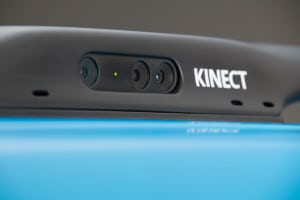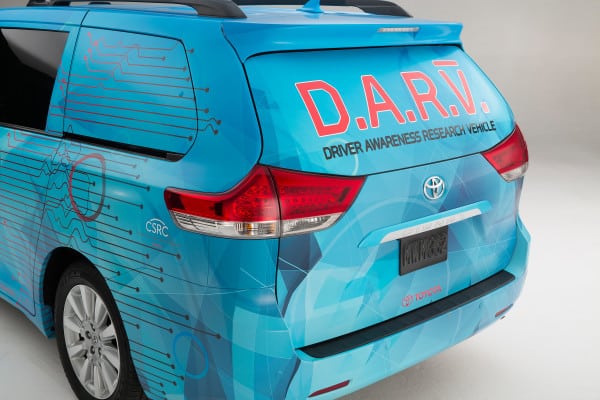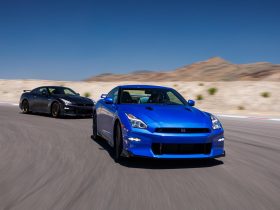A Toyota Sienna minivan outfitted with a Microsoft Kinect integrated system for driver awareness testing has debuted at the Los Angeles Auto Show. Called the Driver Awareness Research Vehicle, or DAR-V, the minivan is being used for three research initiatives aimed at leveraging vehicle design and interaction to help drivers keep their focus on the road.
“At Toyota, our focus is not only on protecting people in case of an accident, but also on preventing that accident from happening in the first place,” said Chuck Gulash, Director of Toyota’s Collaborative Safety Research Center (CSRC). “While the auto industry will never eliminate every potential driver distraction, we can develop new ways to keep driver attention and awareness where it needs to be – on the road ahead.”
The DAR-V is a joint effort between Toyota, Microsoft, and two universities. Using a Toyota Sienna minivan with a Microsoft Kinect device to monitor driver behavior and software they are developing with the help of university students and researchers, Toyota is testing options for the Kinect device as a driver interaction tool. The video below helps explain:
Reducing Distraction Before the Drive
Gulash describes the driver-vehicle interaction as “an interaction of multiple screens.” There’s the windscreen, rear window, side-view mirrors, rear-view mirror, now rear-view camera, gauge clusters, touch screens and infotainment, heads-up displays.. All of that competes for the driver’s attention.
The DAR-V is meant to change that. Partnering with the Microsoft Research lab and building on an early conceptual by Chaotic Moon, the distraction busting of the Sienna test vehicle starts before the driver even gets in the car. The Microsoft Kinect recognizes the driver (obviously a keyfob doesn’t hurt) and immediately begins analyzing known data to predict needs. Mapping and routing, including fuel stops, weather and traffic, is done to pre-plan the trip for the driver. Before even getting into the vehicle, the driver can use gestures and keyfob actions to review, change, or otherwise interact with the van and its systems. All of this can be done inside as well, of course.
The ability to recognize individuals through the Microsoft Kinect system gives an added dimension, allowing the keyfob to merely be the activator (when within range, the Kinect activates and looks at who it is). This makes the system unique to the driver, with each potential driver of the DAR-V having a different profile of needs as the system learns.
This adds options like interactions with children to keep them occupied and helpful to reduce stress levels on parents. (As a parent of toddlers, I can say that this would be awesome!)
Voice Commands thanks to MIT
A big part of this system is the ability to recognize and react to voice commands. The MIT AgeLab is one of the two university partners in this Toyota-Microsoft DAR-V system.
Toyota helped fund a study that helped expand understanding of voice command. The research, headed by lead authors Dr. Bryan Reimer and Bruce Mehler of MIT, found that mental requirements for voice commands were lower than expected, but, interestingly, the voice activation doesn’t necessarily mean less eye-on-the-road distraction. The research found that utilizing voice commands did not reduce the amount of time the drivers took their eyes off the road. Some of this is likely due to our innate human need to make eye contact with those we speak with and this is more pronounced the older the driver was, according to the research.
This interesting bit of information is being used to help Toyota (and others) develop more concise, less distracting voice-activation systems.
Autonomous Driving at Stanford
 The next step in the DAR-V system is to create a semi-autonomous vehicle based on the trust learned through the human-vehicle interface. Sharing driving tasks would reduce accident potential.
The next step in the DAR-V system is to create a semi-autonomous vehicle based on the trust learned through the human-vehicle interface. Sharing driving tasks would reduce accident potential.
Using an advanced driving simulator, researchers at Stanford University are studying how drivers interact with automated safety technologies. Tracking everything from brain activity to emotional arousal and eye-tracking, the system aligns what’s happening inside the car with what’s happening in the simulation.
The simulator can instantly shift from full driver control to fully automated vehicular control or several points between, helping inform design improvements not only for existing technology, but also for bleeding-edge driverless tech being researched now.
Microsoft Kinect and DAR-V
This research is very interesting, to be sure. Integrating a Kinect with a vehicle seems obvious to those who watch developments in both vehicle technologies and gaming, but the way it’s being integrated is just as interesting. Where this research will go is uncertain, but it will certainly lead to advances that will improve safety in the years to come.








